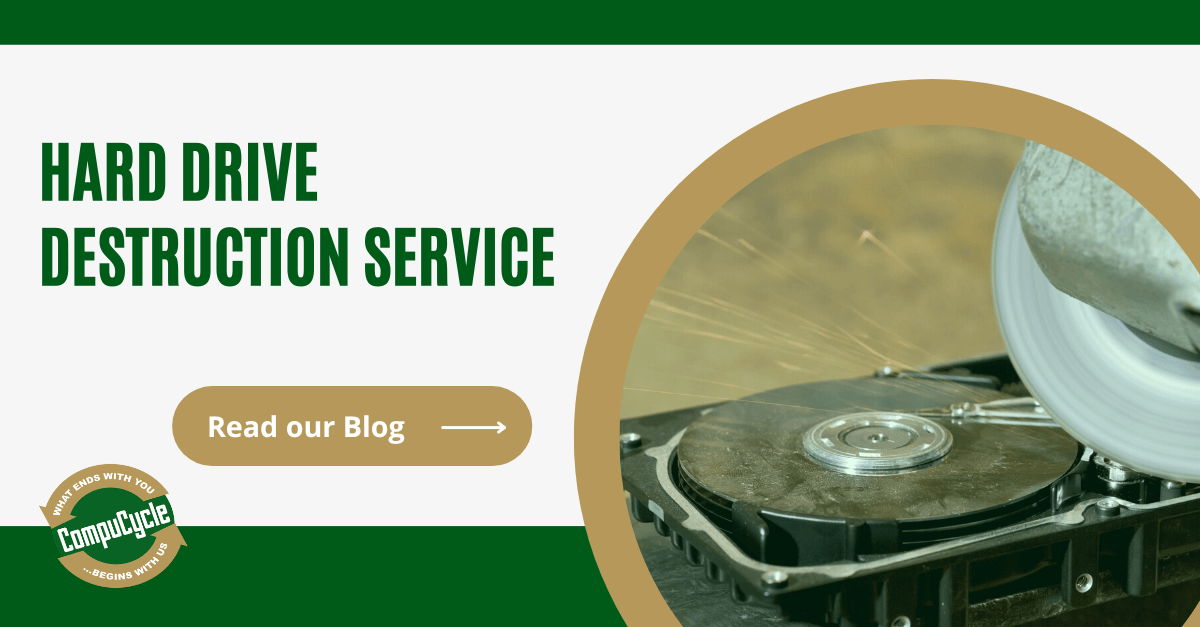How ITAD and Cybersecurity Work Together to Reduce the Impact of Insider Threats

In an era where data breaches are increasingly common, safeguarding information is crucial. Insider threats, whether stemming from malicious intent or unintentional actions, pose significant risks to organizations. A recent study by ID Watchdog revealed a sobering statistic: 60% of data breaches are caused by insider threats [1]. Furthermore, the study found that the number of insider security incidents has risen by 47% since 2018, and the cost of insider threats has risen 31% in the same time period [1].
As companies navigate this growing challenge, strategic IT Asset Disposition (ITAD) emerges as a crucial component in mitigating these threats. At CompuCycle, we understand the importance of implementing effective ITAD practices to ensure proper disposition, safeguarding sensitive information and maintaining organizational integrity. Keep reading to explore the critical role of ITAD in mitigating insider threats this Cybersecurity Awareness Month.
Understanding Cybersecurity and Insider Threats
Cybersecurity is the practice of protecting systems, networks, and data from digital attacks. In today’s increasingly connected world, the need for robust cybersecurity measures is paramount. Insider threats are a significant aspect of this landscape, occurring when individuals within an organization misuse their access to sensitive data. These threats can be classified into two main categories:
Malicious Insider Threats: Employees who deliberately exploit their access for personal gain or to harm the organization. This could include theft of intellectual property, data sabotage, or selling sensitive information to competitors.
Negligent Insider Threats: Well-intentioned employees who inadvertently compromise data security through careless actions, such as mishandling sensitive information, ignoring security protocols, or falling victim to phishing attacks.
Both types of insider threats can lead to serious consequences, including data breaches, financial losses, and damaged reputations. Organizations must recognize that their own employees can be both a valuable asset and a potential risk.
The Importance of IT Asset Disposition
IT Asset Disposition, or ITAD, is a cornerstone for organizations aiming to manage the end-of-life of their IT assets securely and sustainably. Proper asset disposition is not just about getting rid of old equipment; it’s about protecting sensitive information, preventing data breaches, and ensuring compliance with a myriad of regulations.
ITAD involves the secure erasure or destruction of data stored on devices, ensuring that no trace of sensitive information remains. Additionally, it encompasses the recycling or refurbishment of technology assets, which minimizes electronic waste and promotes sustainability. By implementing effective ITAD practices, organizations can maintain control over confidential data, reduce the risk of data breaches, and optimize financial performance. This holistic approach to asset disposition ensures that organizations not only protect their data but also contribute to environmental sustainability.
Adapting to New SEC Cybersecurity Requirements
In 2023, the U.S. Securities and Exchange Commission (SEC) introduced new regulations aimed at enhancing cybersecurity risk management, governance, and incident disclosure for publicly traded companies. These rules require organizations to report significant cybersecurity incidents and outline their approach to cybersecurity risk, including measures for mitigating insider threats. As part of these new requirements, businesses are expected to demonstrate clear protocols for safeguarding sensitive data, which directly ties into secure IT Asset Disposition (ITAD) practices. By integrating comprehensive ITAD strategies, companies can not only comply with these new SEC rulings but also reinforce their cybersecurity frameworks, protecting both their reputation and bottom line.
The Role of Strategic ITAD
Strategic ITAD involves the secure disposal and management of IT assets throughout their lifecycle. As part of a comprehensive approach, it includes asset recovery, decommissioning, data destruction, and environmental sustainability. Here’s how it effectively reduces the impact of insider threats:
- Comprehensive Data Sanitization and Secure Data Erasure
Before any IT asset is retired or repurposed, it must undergo rigorous data sanitization processes, including secure destruction. CompuCycle follows industry best practices to ensure that all sensitive data is irretrievable. By employing advanced data destruction techniques, we eliminate the risk of insider threats related to outdated or disposed-of equipment. - Robust Documentation and Reporting
Transparency is key when it comes to data security. CompuCycle provides detailed documentation of the data destruction process, including certificates of destruction. This level of accountability not only helps organizations meet regulatory compliance but also instills confidence in their data handling practices. - Mitigating Human Error
Relying on internal resources for IT asset disposal can lead to oversight and human error. CompuCycle’s trained professionals specialize in secure data destruction, significantly reducing the chances of mistakes that could expose sensitive information. Our expertise ensures that every step in the ITAD process is executed flawlessly. - Data Lifecycle Management, IT Asset Disposition, and Tracking
Effective ITAD goes beyond just disposal; it encompasses the entire lifecycle of IT assets. This includes data center decommissioning, which focuses on the removal, disposal, data destruction, and asset recovery of outdated technology. By keeping meticulous records of each asset, organizations can better monitor their data exposure and manage potential risks associated with insider threats. CompuCycle provides comprehensive tracking to ensure assets are managed securely from acquisition to disposal. - Promoting a Culture of Security
Implementing strategic ITAD practices can foster a culture of security within an organization. When employees see that their company prioritizes data protection and adheres to stringent ITAD protocols, they are more likely to be vigilant and responsible with sensitive information. This cultural shift can significantly reduce the likelihood of both malicious and negligent insider threats.
Bridging Cybersecurity and ITAD: A Unified Defense Strategy
Both cybersecurity and IT Asset Disposition (ITAD) play crucial roles in mitigating the risks of data breaches at various stages of the data lifecycle. Understanding how these two disciplines work together can enhance an organization’s overall data protection strategy.
-
Data Creation and Storage
Cybersecurity Measures: At the initial stage, strong cybersecurity protocols, such as encryption and access controls, protect sensitive data during its creation and storage. Regular updates and security patches also help safeguard against vulnerabilities that could be exploited by external threats.
ITAD Practices: During this stage, organizations should ensure that any data stored on devices is categorized and managed according to its sensitivity. This involves maintaining an inventory of assets and ensuring secure configurations to minimize exposure. -
Data Usage and Sharing
Cybersecurity Measures: As data is accessed and shared, cybersecurity practices like multi-factor authentication, user training, and monitoring for unusual access patterns are essential. These measures help prevent unauthorized access, whether from malicious insiders or external attackers.ITAD Practices: ITAD processes should be in place to periodically review and audit data access rights, ensuring that only authorized personnel have access to sensitive information. Implementing data loss prevention (DLP) technologies can also minimize the risk of data leaks during sharing.
-
Data Archiving and Retention
Cybersecurity Measures: Effective data archiving strategies should include encryption and access controls to secure stored data. Regular assessments can help identify outdated or unnecessary data that poses risks if retained.
ITAD Practices: ITAD focuses on ensuring that data is retained only as long as necessary and disposed of securely when no longer needed. This includes implementing policies for the timely deletion of sensitive data and ensuring that old devices are decommissioned properly. -
Data Disposal
Cybersecurity Measures: Even at the disposal stage, cybersecurity considerations remain critical. Ensuring that data is securely wiped from devices before disposal prevents unauthorized recovery, which could lead to breaches.
- ITAD Practices: ITAD involves rigorous data sanitization techniques, such as physical destruction or certified data erasure, to guarantee that sensitive information is irretrievable. Providing documentation of these processes further strengthens an organization’s compliance and accountability.
The Risks of Relying on Internal Employees for ITAD
Hiring a certified company like CompuCycle for IT Asset Disposition (ITAD) is crucial for ensuring the secure and compliant handling of sensitive data. While relying on internal employees may seem convenient, it often leads to oversights and potential vulnerabilities that could expose the organization to insider threats.
Certified ITAD providers follow stringent protocols and industry best practices for data destruction, ensuring that all sensitive information is irretrievable. They also offer detailed documentation and certificates of destruction, which are essential for regulatory compliance. By partnering with a trusted expert like CompuCycle, organizations can mitigate risks, enhance their data security posture, and focus on their core operations with peace of mind.
Best Practices for Corporate ITAD Implementation
Implementing effective ITAD practices requires a comprehensive approach that involves multiple stakeholders and departments within an organization. Here are some best practices to consider:
- Develop a Clear ITAD Policy and Procedure: Establish a well-defined ITAD policy that outlines the processes and responsibilities for asset disposition.
Conduct Regular IT Asset Inventory and Tracking: Maintain an up-to-date inventory of all IT assets to ensure accurate tracking and management. - Implement Secure Data Erasure and Destruction Methods: Use industry-standard methods for data erasure and destruction to ensure that sensitive information is completely removed.
- Recycle or Refurbish IT Assets Whenever Possible: Promote sustainability by recycling or refurbishing IT assets instead of simply disposing of them.
Ensure Compliance with Relevant Regulations and Standards: Stay informed about and comply with all relevant regulations and industry standards. - Provide Training and Awareness Programs for Employees: Educate employees about the importance of ITAD and their role in the process.
- Continuously Monitor and Evaluate ITAD Practices: Regularly review and improve ITAD practices to ensure they remain effective and compliant.
By following these best practices, organizations can ensure the secure and responsible disposal of their IT assets, minimize electronic waste, and promote sustainability.
Choosing the Right ITAD Partner
Selecting the right ITAD partner is crucial for ensuring the secure and responsible disposal of IT assets. When evaluating potential partners, organizations should consider several key factors. First, the partner’s reputation and experience in the ITAD market are paramount. Look for ITAD companies that offer comprehensive services, including secure data erasure, asset destruction, and recycling.
A critical factor in ensuring data security is whether the ITAD provider handles processing in-house. CompuCycle prides itself on its in-house processing capabilities, which prevent sensitive IT assets from ending up in the hands of third-party processors. By managing the entire process internally, CompuCycle maintains strict control over data security, ensuring that sensitive information is never exposed to external risks during disposal.
It’s also essential to ensure that the partner provides a guarantee of secure data handling and disposal. Organizations should ensure that their partner provides a guarantee for secure data handling and disposal. This includes obtaining detailed documentation and reports that serve as definitive proof of data erasure, demonstrating that sensitive information has been permanently removed from all devices. Certifications from reputable organizations, such as the National Association for Information Destruction (NAID) or e-Stewards, can provide additional assurance of their capabilities.
Reflections During Cybersecurity Awareness Month
As insider threats continue to be a pressing concern for organizations, adopting a strategic approach to IT asset disposition is essential. CompuCycle’s commitment to secure data destruction and comprehensive ITAD practices helps mitigate the risks associated with insider threats. By choosing a certified ITAD provider, organizations can protect their sensitive data, ensure compliance, and foster a secure environment. If you’re looking to strengthen your organization’s cybersecurity posture and reduce the impact of insider threats, contact CompuCycle today. Together, we can create a robust strategy for managing your IT assets securely.
Source:
[1] ID Watchdog. “Insider Threats and Data Breaches.” Accessed September 23, 2024. https://www.idwatchdog.com/insider-threats-and-data-breaches
Excited to learn more? Explore our other informative blog articles!
- https://compucycle.com/blog/e-waste-and-cybersecurity/
- https://compucycle.com/blog/data-sanitization-over-data-destruction-data-lifecycle-management-for-it-managers/
Learn more about CompuCycle’s IT Asset Disposal and secure data destruction services. For more information, visit CompuCycle.com, contact us online or call us at (713) 869-6700 to schedule a tour of our facility.





